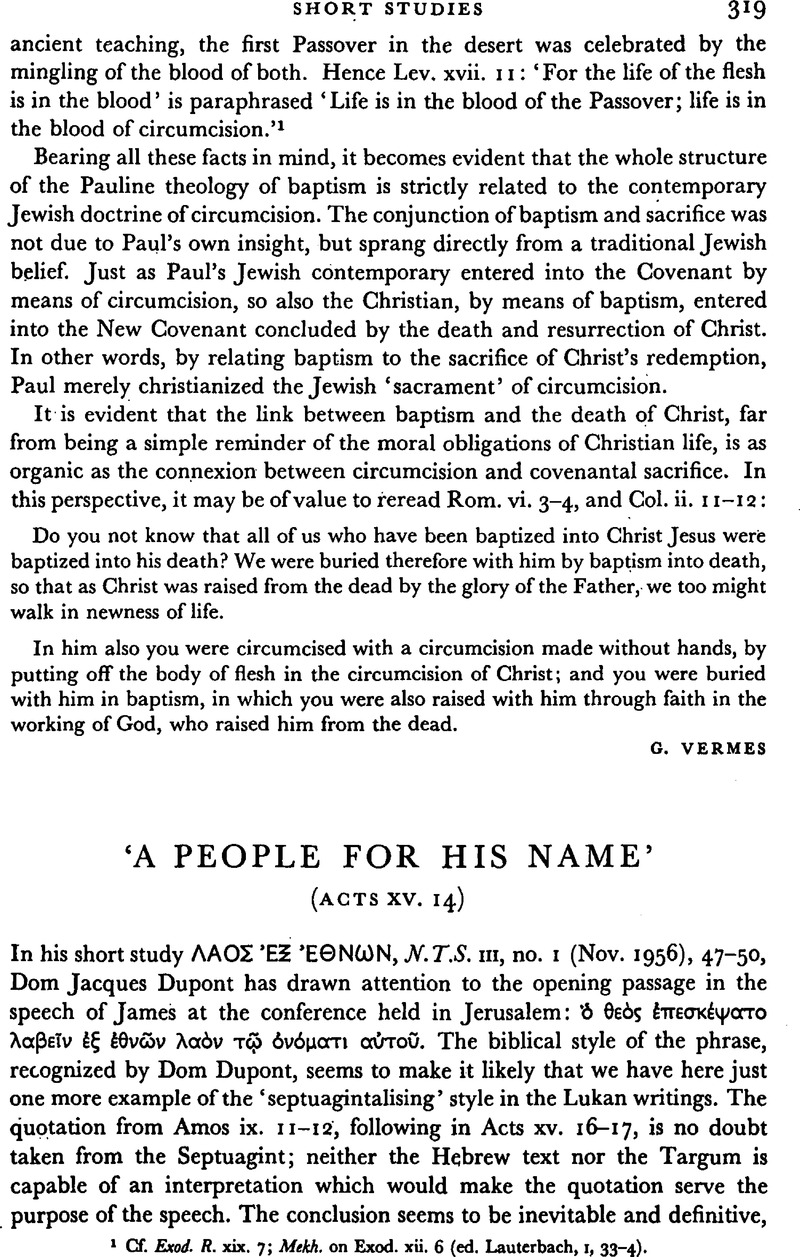Article contents
‘A People for his Name’
Published online by Cambridge University Press: 05 February 2009
Abstract

- Type
- Short Studies
- Information
- Copyright
- Copyright © Cambridge University Press 1958
References
page 319 note 1 Cf. Exod. R. xix. 7; Mekh. on Exod. xii. 6 (ed. Lauterbach, I, 33–4).Google Scholar
page 320 note 1 I have used the edition from Basel 1618–19. For translation into English I have made use of Etheridge, J. W., The Targums, I–II (London, 1862–1865).Google Scholar
page 321 note 1 See Black, M., ‘The Recovery of the Language of Jesus’, N.T.S. III, no. 4 (07 1957), 305–14,Google Scholar and ‘Die Erforschung der Muttersprache Jesu’, Theol. Lit.-Zeit. LXXXII, no.9 (Sept. 1957), esp. 660–4.Google Scholar
page 322 note 1 Further examples, not referred to in the text, are: Deut. xiv. 21; xxvii. 9; xxviii. I Sam. xii. 22; II Sam. vii. 24;Jer. vii. 23; xi. 4; xiii. II; xxiv. 7; xxx. 22 xxxi. I, 33; xxxii. 38; Ezek. xi. 20; xiv. II; xxxvii. 23, 27; Zech. viii. 8.Google Scholar
page 322 note 2 According to New Testament Abstracts, I (1957), 189f.,Google ScholarWilcox, M., ‘The Old Testament in Acts 1–15’, Australian Bibi. Rev. v (1956), 1–41, has found affinity to Aramaic and Samaritan sources in Acts xiii. 22 and II vii. 3,5, 10b, 4 and 32, and affinity to TM in vii. i6 and viii. 32. The article has not been accessible to me.Google Scholar
page 322 note 3 ‘Miszellen zur Apostelgeschichte, 2, Acta 15, 14 und die lukanische Kompositionstechnik’, Evangelische Theologie, XVII (1957), 399–406.Google Scholar
page 322 note 4 According to E. Brederek, Konkordanz zum Targum Onkelos (ZAW Bh. g), Giessen, 1906, the word is only used in Gen. xxv. 16 and Num. XXV. 15.Google Scholar
page 325 note 1 To this simple, but fundamental observation, not even the best study on ![]() , known to me, has paid sufficient attention: Rost, L.: ‘Die Bezeichnungen für Land und Volk im A.T.’, Festschrift Otto Procksch (Leipzig, 1934), pp. 125–48.Google Scholar Rost concludes by the following definition:
, known to me, has paid sufficient attention: Rost, L.: ‘Die Bezeichnungen für Land und Volk im A.T.’, Festschrift Otto Procksch (Leipzig, 1934), pp. 125–48.Google Scholar Rost concludes by the following definition: ![]() bezeichnet die Gesamtbevölkerung eines Territoriums,
bezeichnet die Gesamtbevölkerung eines Territoriums, ![]() die Mannschaft eines Volkes als die Zusammenfassung der verheirateten, auf eigener Scholle sitzenden Vollbürger mit dem Recht zur Dienstleistung im Heerbann, zur Teilnahme an der Rechtssprcchung und zur Ausübung des Kultes’ (p. 147). The word
die Mannschaft eines Volkes als die Zusammenfassung der verheirateten, auf eigener Scholle sitzenden Vollbürger mit dem Recht zur Dienstleistung im Heerbann, zur Teilnahme an der Rechtssprcchung und zur Ausübung des Kultes’ (p. 147). The word ![]() like the term
like the term ![]() , certainly often can have this meaning, but this is a specific, technical use, rather than the basic meaning of the word.
, certainly often can have this meaning, but this is a specific, technical use, rather than the basic meaning of the word.
page 326 note 1 Cf. Noth, M., Geschichte Israels (Göttingen, 1950).Google Scholar
- 8
- Cited by




